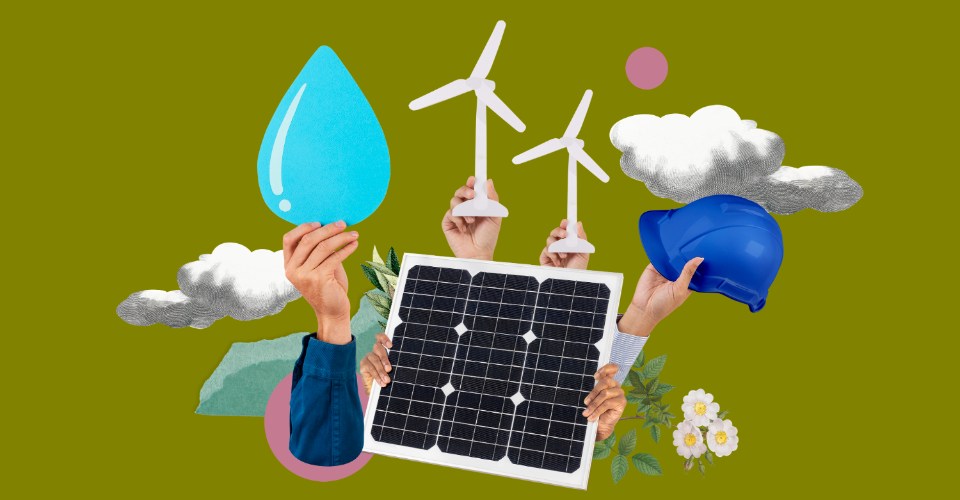The Green Revolution is Here
Imagine a world where clean, renewable energy powers homes, vehicles, and industries, drastically reducing pollution. This isn’t a far-off dream but a fast-evolving reality thanks to groundbreaking advancements in green technology. As we explore these innovations, let’s dive into the pivotal role they play in reshaping the global economy, curbing carbon footprints, and fostering sustainable living.
Top 8 Renewable Energy Innovations Making a Real Difference
1. Solar Energy Revolution: A Bright Future Ahead
Solar power stands as a cornerstone in the global transition to sustainable energy, with groundbreaking advancements reshaping how we harness the sun’s energy. The integration of photovoltaic systems into residential, commercial, and industrial sectors has driven unprecedented growth in this domain.
Advancements in Solar Technology
- Higher Efficiency Panels: Modern photovoltaic panels now achieve over 22% efficiency, converting sunlight into electricity more effectively.
- Transparent Solar Panels: A game-changer for urban spaces, these panels transform windows and glass surfaces into energy-generating systems, merging functionality with sustainability.
- Flexible Solar Films: Lightweight and versatile, these films can be integrated into vehicles, clothing, and portable devices.
The Growth of Solar Energy
- Solar energy capacity has increased almost 18-fold between 2009 and 2020, reflecting widespread adoption and falling costs (SEIA).
- The average cost of solar photovoltaic (PV) systems dropped by over 70% in the last decade (IRENA).
Environmental and Economic Impact
- Carbon Reduction: A single residential solar system can offset approximately 3-4 metric tons of CO2 annually.
- Economic Benefits: In 2022, the solar industry employed over 250,000 workers in the U.S., making it one of the fastest-growing sectors (Solar Foundation).
Future Potential
- Innovations like solar roof tiles and energy-storing solar paints are under development, promising to make solar energy more accessible and efficient.
- The International Energy Agency predicts solar will account for 60% of the global renewable energy mix by 2050.
The solar energy revolution demonstrates how leveraging the power of the sun can lead to sustainable growth, reduced environmental impact, and a brighter future for our green economy. It’s more than an energy solution—it’s a commitment to a sustainable tomorrow.
2. Next-Gen Battery Storage: Powering the Future of Energy
As renewable energy innovations like solar and wind continue to grow, the ability to store that energy efficiently becomes increasingly vital. Battery technology is the linchpin for ensuring these sustainable energy sources remain reliable even when the sun isn’t shining or the wind isn’t blowing.
Why Advanced Battery Storage Matters
- Bridging Intermittency: Batteries stabilize energy supply by storing surplus power for use during periods of high demand or low production.
- Supporting the Grid: Advanced storage systems enable grid flexibility, ensuring smooth integration of renewable energy sources like solar farms and wind turbines.
- Decentralized Energy Solutions: They empower homes and businesses to adopt renewable energy without dependency on centralized grids.
Key Statistics: The Growth of Energy Storage
- Global battery storage capacity is expected to surge from 1.2 GW in 2020 to 7.5 GW by 2025 (Energy Information Administration).
- By 2030, the battery market for energy storage is projected to be worth $50 billion (BloombergNEF).
The Latest in Battery Technology
- Solid-State Batteries:
- Higher energy density than lithium-ion cells.
- Offer faster charging times and enhanced safety.
- Expected to reduce costs as production scales up.
- Applications include electric vehicles and large-scale energy storage systems.
- Flow Batteries:
- Use liquid electrolytes to store energy, ideal for large-scale renewable energy projects.
- Can achieve lifespans of 20+ years with minimal degradation.
- Recycling Innovations:
- Emerging methods allow up to 95% recovery of critical materials like lithium, nickel, and cobalt, reducing the environmental impact of battery manufacturing (World Economic Forum).
- Emerging methods allow up to 95% recovery of critical materials like lithium, nickel, and cobalt, reducing the environmental impact of battery manufacturing (World Economic Forum).
Future Outlook
As the green economy continues to grow, investment in cutting-edge battery innovations will play a pivotal role in reducing carbon emissions and advancing sustainability. By addressing challenges like energy intermittency and efficiency, next-gen batteries will accelerate the adoption of renewable energy on a global scale.
3. Wind Power Goes Offshore
Offshore wind power is transforming how we generate renewable energy by harnessing the strong and steady winds over oceans and large lakes. Unlike onshore wind farms, offshore facilities benefit from less turbulence and higher wind speeds, enabling them to produce significantly more power.
Key Benefits of Offshore Wind Energy
- Higher Energy Yield: Offshore turbines can generate up to twice the electricity of onshore turbines due to stronger and more consistent wind speeds.
- Reduced Land Use: By moving wind farms to water, we save valuable land space for other uses while minimizing disruption to communities.
- Clean Energy Generation: Offshore wind contributes significantly to reducing greenhouse gas emissions by displacing fossil fuel-based electricity.
Key Stat
According to the U.S. Department of Energy (DOE), offshore wind power could generate enough electricity to supply up to 18 million American homes by 2030. Globally, the offshore wind market is projected to grow at a compound annual rate of 13%, reaching an installed capacity of 228 GW by 2030 (IRENA).
Innovations in Offshore Wind Technology
- Floating Turbines: These advanced structures allow turbines to be deployed in deeper waters, where winds are stronger and less obstructed. Floating wind farms, such as Hywind Scotland, have already proven their efficiency, with capacity factors reaching 57%—far exceeding the average for traditional wind power.
- Bigger Blades: Modern turbines feature blades exceeding 100 meters in length, maximizing their energy capture potential.
- Grid Integration: Innovative subsea cables connect offshore wind farms to national grids, ensuring stable and efficient energy transmission.
Global Adoption
Countries like the U.K., China, and Denmark are leading the offshore wind revolution, with Europe alone hosting over 75% of the world’s offshore wind capacity (WindEurope). By investing in this technology, we can advance renewable energy innovations and reduce our carbon footprint while fostering a thriving green economy.
4. Green Hydrogen Energy: A Revolution in Clean Power
Green hydrogen represents one of the most promising advancements in clean energy, with the potential to transform how we power industries and transportation. Unlike traditional hydrogen production, which relies on fossil fuels, green hydrogen is created through electrolysis—a process that splits water into hydrogen and oxygen using electricity generated from renewable sources like solar and wind. This makes it entirely carbon-free, aligning with global goals for significant carbon reduction.
Why Green Hydrogen Matters
- Environmental Benefits: Producing green hydrogen emits zero greenhouse gases, making it a sustainable alternative to fossil fuels for energy-intensive sectors.
- Versatile Applications: Green hydrogen can replace traditional fuels in heavy industries like steel and cement production, sectors that account for nearly 20% of global CO2 emissions (IEA).
- Energy Storage: Hydrogen serves as an efficient storage medium for surplus renewable energy, ensuring a steady supply when solar and wind outputs fluctuate.
Key Statistics
- Green hydrogen could fulfill 24% of global energy demand by 2050, helping to reduce CO2 emissions by up to 6 gigatons annually (Hydrogen Council).
- By 2030, the cost of producing green hydrogen is projected to drop by 50%, making it competitive with fossil fuels (IRENA).
Applications of Green Hydrogen
- Heavy Industries: Provides a clean energy source for sectors like steel and ammonia production, which traditionally depend on coal and natural gas.
- Transportation: Hydrogen fuel cells power vehicles ranging from cars to trains and even airplanes, enabling zero-emission travel.
- Grid Stabilization: Hydrogen-powered systems can act as long-term energy reserves, ensuring consistent energy delivery during peak demands.
Global Initiatives Driving Growth
Countries like Japan, Germany, and Australia are heavily investing in green hydrogen infrastructure, with over $500 billion allocated to accelerate its adoption by 2030.
Green hydrogen not only embodies innovation in renewable energy but also acts as a cornerstone for achieving a sustainable, low-carbon global economy.
5. Eco-Friendly Manufacturing: Redefining Industry Standards
Eco-friendly manufacturing, also known as sustainable production, focuses on reducing waste, conserving energy, and utilizing renewable or recycled materials in production processes. This innovative approach not only minimizes environmental impact but also boosts efficiency and reduces costs for industries worldwide.
Why It Matters
- Reduced Environmental Impact: Traditional manufacturing contributes significantly to carbon emissions and resource depletion. Adopting sustainable practices helps industries align with global carbon reduction goals.
- Regulatory Compliance: Many nations are enforcing stricter environmental laws, making eco-conscious production a necessity rather than an option.
Key Innovations in Sustainable Production
- 3D Printing Revolution
- Enables precise material usage, eliminating up to 90% of waste during production (McKinsey).
- Applications range from aerospace components to custom medical devices.
- Recycled and Renewable Materials
- Companies are using bio-based plastics and recycled metals, reducing dependence on virgin materials.
- Example: Adidas produces shoes from ocean plastic waste, cutting down on pollution.
- Energy-Efficient Machinery
- Advanced robotics and AI-driven systems optimize production processes, reducing energy consumption by 30% or more.
- Example: Smart factories use predictive maintenance to prevent energy wastage.
Impact on the Green Economy
- Economic Growth: Transitioning to sustainable manufacturing has created a market estimated to be worth $1 trillion by 2030 (Bloomberg NEF).
- Job Creation: The shift fosters new industries and job opportunities in recycling, renewable materials, and green technology sectors.
Key Stat
A study by the World Economic Forum found that adopting sustainable manufacturing practices globally could cut annual carbon emissions by 12 gigatons, equivalent to the emissions from 2.6 billion cars.
By integrating eco-friendly practices, industries are not only contributing to a sustainable future but also gaining a competitive edge in the evolving green economy.
6. Carbon Capture, Utilization, and Storage (CCUS)
Carbon Capture, Utilization, and Storage (CCUS) is a groundbreaking technology designed to address carbon emissions from industrial processes. By capturing CO2 at its source, CCUS prevents it from entering the atmosphere. The captured carbon can either be stored deep underground or repurposed for other applications, such as enhancing oil recovery or creating industrial products like concrete and biofuels.
How CCUS Works
- Capture: CO2 is separated from industrial emissions using chemical solvents, membranes, or cryogenic processes.
- Transport: The CO2 is compressed and transported via pipelines, ships, or rail to designated storage or utilization sites.
- Storage or Utilization: Captured CO2 is either stored in geological formations like depleted oil fields or converted into useful products.
Key Statistics
- According to the Global CCS Institute, there are 26 operational large-scale CCUS facilities worldwide, collectively capturing over 40 million tonnes of CO2 annually.
- Projections suggest that by 2050, CCUS could capture and store up to 7 gigatonnes of CO2 per year, significantly contributing to global climate targets.
- The International Energy Agency (IEA) estimates CCUS must account for nearly 15% of the total emissions reduction required to meet net-zero goals by 2050.
Real-World Applications
- Cement Industry: Cement plants, major contributors to CO2 emissions, utilize CCUS to reduce their environmental impact. For example, Norway’s Brevik Cement Plant is integrating full-scale CCUS technology to capture up to 400,000 tonnes of CO2 annually.
- Energy Production: Power plants burning fossil fuels are retrofitted with CCUS to mitigate their carbon output while maintaining energy reliability.
The Future of CCUS
With advancements in carbon capture and increased investments, CCUS is poised to play a vital role in carbon reduction strategies. Governments and industries are setting ambitious targets, and scaling up this technology can accelerate the transition to a low-carbon economy.
7. Smart Energy Grids: A Foundation for Renewable Energy Innovations
Smart energy grids represent a transformative leap in how we manage, distribute, and optimize power. These advanced systems are designed to seamlessly integrate renewable energy sources, ensuring that energy is delivered efficiently and reliably to consumers. By leveraging cutting-edge technologies like real-time analytics and artificial intelligence (AI), smart grids address the challenges of fluctuating supply from renewable sources while meeting dynamic energy demands.
Why Smart Grids Matter
Smart grids are pivotal in modernizing aging energy infrastructures. Unlike traditional grids, which are rigid and prone to outages, smart grids:
- Enable real-time communication between energy producers and consumers.
- Optimize energy distribution by predicting demand patterns.
- Support renewable energy integration by stabilizing output from intermittent sources like solar and wind.
The Numbers Speak
- The global smart grid market is anticipated to reach $61 billion by 2025 (Market Insights), driven by increasing renewable energy adoption.
- Smart grid technology could reduce electricity losses by up to 40% compared to conventional grids (International Energy Agency).
Key Innovations Driving Smart Grids
- Real-Time Analytics:
- Predicts energy demand with precision.
- Reduces waste by matching supply to real-time needs.
- Artificial Intelligence (AI):
- Automates decision-making processes for energy distribution.
- Detects and resolves system anomalies swiftly.
- IoT-Enabled Devices:
- Smart meters and appliances provide users with detailed energy consumption insights.
- Facilitates demand-side energy management, empowering consumers to reduce usage during peak times.
The Environmental Impact
Smart grids contribute to carbon reduction by maximizing the efficiency of renewable energy use. According to the U.S. Department of Energy, adopting smart grid technology can cut greenhouse gas emissions by up to 12% annually.
Smart energy grids are not just a technological advancement—they are a cornerstone of the global shift toward a sustainable, renewable-powered future, fostering both innovation and a robust green economy.
8. Plant-Based Packaging: A Sustainable Alternative to Plastics
The excessive use of single-use plastics has long been a global environmental concern, contributing to massive pollution and harming ecosystems. Plant-based packaging offers a groundbreaking solution, replacing conventional plastics with biodegradable alternatives derived from renewable sources like corn, sugarcane, and cassava.
How It Works
Plant-based materials are processed to create bioplastics, which can decompose naturally, unlike traditional plastics that take centuries to break down. These materials significantly reduce waste, require less fossil fuel during production, and offer a sustainable option for packaging.
Key Benefits
- Pollution Reduction: Bioplastics degrade faster, cutting down on landfill accumulation.
- Resource Conservation: They rely on renewable crops instead of petroleum-based materials.
- Lower Carbon Footprint: Production emits fewer greenhouse gases compared to traditional plastic manufacturing.
Informational Insights
- The global bioplastics market is experiencing rapid growth, with production capacity projected to increase by 36% by 2024 (European Bioplastics).
- The shift to sustainable packaging can save up to 1 million barrels of oil annually, according to the World Economic Forum.
- Studies indicate that widespread adoption of bioplastics could reduce CO2 emissions by as much as 70% over their lifecycle.
Innovative Examples
- Edible Cutlery: Forks, spoons, and knives made from rice or wheat that are fully compostable and even edible.
- Compostable Bags: Grocery and trash bags that degrade entirely within months when composted.
- Bio-based Bottles: Alternatives to PET bottles, such as those made from plant-derived polyethylene.
The Bigger Picture
Plant-based packaging exemplifies how eco-friendly manufacturing and carbon reduction efforts can intersect to create impactful solutions. By adopting these alternatives, businesses not only align with a green economy but also cater to an increasing consumer demand for sustainability. As the technology advances and costs decline, plant-based packaging is set to play a pivotal role in reducing plastic waste and fostering a cleaner planet.
Key Takeaways
- Renewable technologies like solar and wind are transforming global energy landscapes.
- Breakthroughs in battery storage and hydrogen fuel are pivotal for energy resilience.
- Green manufacturing and plant-based packaging contribute to a circular economy.
At a Glance: The Impact of Green Innovations
- Reduction in Emissions: By up to 45% by 2050 (Ellen MacArthur Foundation).
- Job Creation: 11 million renewable energy jobs worldwide in 2018 (IRENA).
- Economic Growth: A projected $10 trillion global green economy by 2030 (Bloomberg).
FAQs
1. What is the most promising renewable energy source?
Solar and wind energy are leading due to their scalability and rapidly declining costs.
2. What are the main barriers to adopting green technology?
High initial costs, limited infrastructure, and uneven regulatory policies pose significant challenges.
3. How does green technology impact the economy?
It stimulates job creation, reduces healthcare costs associated with pollution, and boosts sustainable economic growth.
Conclusion: A Greener Tomorrow Awaits
Green technology is more than a trend—it’s a necessity for combating climate change and building a sustainable future. By adopting these innovations, we can reduce carbon emissions, conserve resources, and foster a thriving green economy. Together, let’s invest in and advocate for these solutions to secure a better world for generations to come.



















Leave a Reply